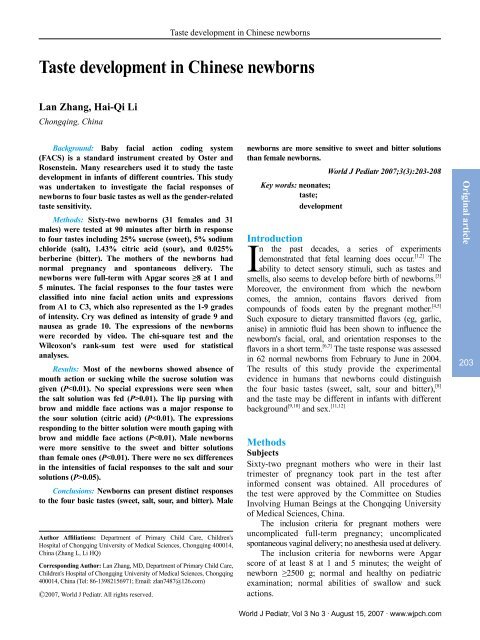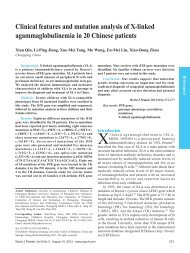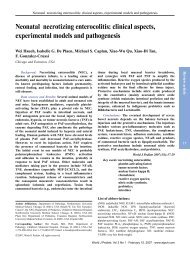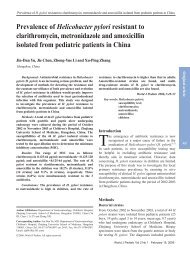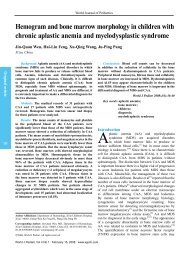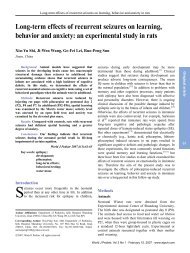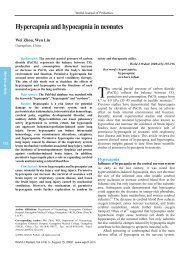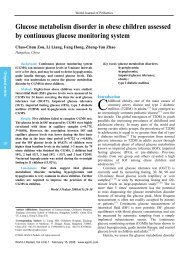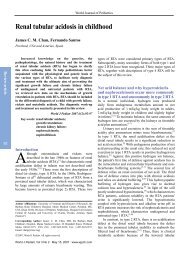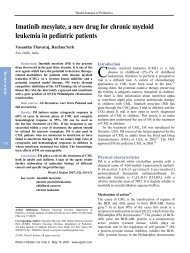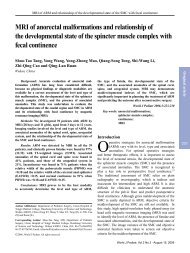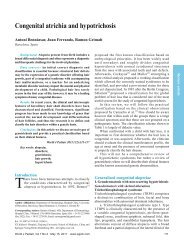Taste development in Chinese newborns - World Journal of Pediatrics
Taste development in Chinese newborns - World Journal of Pediatrics
Taste development in Chinese newborns - World Journal of Pediatrics
You also want an ePaper? Increase the reach of your titles
YUMPU automatically turns print PDFs into web optimized ePapers that Google loves.
<strong>Taste</strong> <strong>development</strong> <strong>in</strong> Ch<strong>in</strong>ese <strong>newborns</strong><strong>Taste</strong> <strong>development</strong> <strong>in</strong> Ch<strong>in</strong>ese <strong>newborns</strong>Lan Zhang, Hai-Qi LiChongq<strong>in</strong>g, Ch<strong>in</strong>aBackground: Baby facial action cod<strong>in</strong>g system(FACS) is a standard <strong>in</strong>strument created by Oster andRosenste<strong>in</strong>. Many researchers used it to study the taste<strong>development</strong> <strong>in</strong> <strong>in</strong>fants <strong>of</strong> different countries. This studywas undertaken to <strong>in</strong>vestigate the facial responses <strong>of</strong><strong>newborns</strong> to four basic tastes as well as the gender-relatedtaste sensitivity.Methods: Sixty-two <strong>newborns</strong> (31 females and 31males) were tested at 90 m<strong>in</strong>utes after birth <strong>in</strong> responseto four tastes <strong>in</strong>clud<strong>in</strong>g 25% sucrose (sweet), 5% sodiumchloride (salt), 1.43% citric acid (sour), and 0.025%berber<strong>in</strong>e (bitter). The mothers <strong>of</strong> the <strong>newborns</strong> hadnormal pregnancy and spontaneous delivery. The<strong>newborns</strong> were full-term with Apgar scores ≥8 at 1 and5 m<strong>in</strong>utes. The facial responses to the four tastes wereclassified <strong>in</strong>to n<strong>in</strong>e facial action units and expressionsfrom A1 to C3, which also represented as the 1-9 grades<strong>of</strong> <strong>in</strong>tensity. Cry was def<strong>in</strong>ed as <strong>in</strong>tensity <strong>of</strong> grade 9 andnausea as grade 10. The expressions <strong>of</strong> the <strong>newborns</strong>were recorded by video. The chi-square test and theWilcoxon's rank-sum test were used for statisticalanalyses.Results: Most <strong>of</strong> the <strong>newborns</strong> showed absence <strong>of</strong>mouth action or suck<strong>in</strong>g while the sucrose solution wasgiven (P0.01). The lip purs<strong>in</strong>g withbrow and middle face actions was a major response tothe sour solution (citric acid) (P
<strong>World</strong> <strong>Journal</strong> <strong>of</strong> <strong>Pediatrics</strong>Orig<strong>in</strong>al articleMethodsThe modified Rosenste<strong>in</strong>'s solutions [8] <strong>in</strong>cluded 25%sucrose (sweet), 5% sodium chloride (salt), 1.43%citric acid (sour), and 0.025% berber<strong>in</strong>e (bitter). Thesolutions and room temperatures were kept at 37ºCand 28ºC respectively.Test<strong>in</strong>gThe <strong>newborns</strong> were tested at 90 m<strong>in</strong>utes after birth.About 0.2 ml each <strong>of</strong> the four taste solutions was droppedat the central portion <strong>of</strong> the dorsal surface <strong>of</strong> the <strong>in</strong>fant'stongue. Then distilled water (0.4 ml) was used as a r<strong>in</strong>seto m<strong>in</strong>imize carry-over effects from one solution toanother for 90 seconds. Dur<strong>in</strong>g test<strong>in</strong>g, the <strong>newborns</strong>should be held upright fac<strong>in</strong>g forward. All the expressions<strong>of</strong> the <strong>newborns</strong> were recorded by video. Test<strong>in</strong>g sessionsconsisted <strong>of</strong> two consecutive 30-second presentations <strong>of</strong>each <strong>of</strong> the four solutions, separated by two 90-secondwater r<strong>in</strong>ses. The order <strong>of</strong> the four solutions wasdeterm<strong>in</strong>ed by a modified Lat<strong>in</strong> square design.Data analysisThe data were analyzed by the statistical analysissystem 8.1. Frequency and <strong>in</strong>tensity <strong>of</strong> the facial actionunits recorded were analyzed. The chi-square test andWilcoxon's rank-sum test were used for statistical analysis.P
<strong>Taste</strong> <strong>development</strong> <strong>in</strong> Ch<strong>in</strong>ese <strong>newborns</strong>frequency <strong>of</strong> A1 expression was lower <strong>in</strong> sour responsethan <strong>in</strong> other taste responses (3.23%) (P0.01 0.2277 >0.01C2 - - 0.2277 >0.01 - - 11.1589 0.01 0.0094 >0.01 5.8612 >0.01Orig<strong>in</strong>al articleTable 3. Intensity <strong>of</strong> the facial expressions to the four tastes <strong>in</strong> the <strong>newborns</strong>A1grade 1A2grade 2A3grade 3B1grade 4B2grade 5B3grade 6C1grade 7C2grade 8C3 or cry<strong>in</strong>g nauseagrade 9Sweet 58 0 3 0 0 1 0 0 0 0Salt 17 5 7 0 6 5 1 1 17 3Sour 2 3 0 5 10 16 3 0 16 7Bitter 13 9 11 2 1 0 2 6 17 1Nauseagrade 10Table 4. The frequency <strong>of</strong> facial action units to the four tastes <strong>in</strong> male <strong>newborns</strong>Sweet Salt Sour BitterNo. Frequency (%) No. Frequency (%) No. Frequency (%) No. Frequency (%)A1* 27 87.10 8 25.81*2 6.45 7 22.58A2 0 1 3.23 3 9.68 1 3.23A3 3 9.68 7 22.58 0 6 19.35B1 0 0 2 6.45 1 3.23B2 0 1 3.23 5 8.06 3 9.68B3 1 3.23 7 22.58* 11 35.48 0C1 0 0 1 3.23 2 6.45C2 0 0 0* 4 12.90C3 0 7 22.58 7 22.58 7 22.58*: P0.01 3.4039 >0.01 0.0695 >0.01A3 0.3827 >0.01 3.4444 >0.01 - - 1.5309 >0.01B1 - - - - 2.8466 >0.01 0.1139 >0.01B2 - - 0.9984 >0.01 4.8322 >0.01 0.3594 >0.01B3 4.6617 >0.01 1.6782 >0.01 15.5795 0.01 2.8466 >0.01C2 - - - - - - 12.400 0.01 0.9364 >0.01 0.9364 >0.01<strong>World</strong> J Pediatr, Vol 3 No 3 . August 15, 2007 . www.wjpch.com
<strong>World</strong> <strong>Journal</strong> <strong>of</strong> <strong>Pediatrics</strong>Orig<strong>in</strong>al article<strong>newborns</strong> respond as grades 1 and 2 <strong>in</strong>tensity. 20 and 23<strong>newborns</strong> responded to the salt and the sour solutions asgrades 9 and 10 <strong>of</strong> <strong>in</strong>tensity, respectively (Table 3).The sex differentiation <strong>in</strong> facial responsesTo the sucrose solution, 27 male <strong>newborns</strong> (87.10%)showed expression A1, which was the highest frequency<strong>of</strong> expression A1 among the four tastes (P0.01).To the sour solution, 6.45% <strong>of</strong> the male <strong>newborns</strong>showed expression A1, which was the lowest frequency<strong>of</strong> expression A1 among the four tastes, and 75.80%showed expression B and C, <strong>in</strong>clud<strong>in</strong>g 35.48% withexpression B3, which was higher than the B3 frequencycompared to the non-sour solutions (P0.01 - -C2 - - 0.6776 >0.01 0.6776 >0.01 0.2335 >0.01C3 - - 1.8419 >0.01 0.6631 >0.01 5.9679 >0.01Table 8. The frequency <strong>of</strong> the <strong>in</strong>tensity to the four tastes <strong>in</strong> the male <strong>newborns</strong>A1grade 1A2grade 2A3grade 3B1grade 4B2grade 5<strong>World</strong> J Pediatr, Vol 3 No 3 . August 15, 2007 . www.wjpch.comB3grade 6C1grade 7C2grade 8C3 or cry<strong>in</strong>ggrade 9Sweet 27 0 3 0 0 1 0 0 0 0Salt 8 1 6 0 1 4 0 0 9 2Sour 2 3 0 0 4 6 3 0 9 4Bitter 7 1 6 1 1 0 2 5 7 1Table 9. Intensity <strong>of</strong> facial action units to the four tastes <strong>in</strong> the female <strong>newborns</strong>A1grade 1A2grade 2A3grade 3B1grade 4B2grade 5B3grade 6C1grade 7C2grade 8C3 or cry<strong>in</strong>ggrade 9Sweet 31 0 0 0 0 0 0 0 0 0Salt 9 4 1 0 5 1 1 1 8 1Sour 0 0 0 5 6 10 0 0 7 3Bitter 6 8 5 1 0 0 0 1 10 0Nauseagrade 10Nauseagrade 10
<strong>Taste</strong> <strong>development</strong> <strong>in</strong> Ch<strong>in</strong>ese <strong>newborns</strong>had expression A, and 12.90% had expression C2(P0.01). Thirteen female <strong>newborns</strong> (33.87%)demonstrated expression A2 and A3, the frequency <strong>of</strong>expression A was higher than that <strong>of</strong> the other threesolutions (P0.01) (Tables 4-7).There were significant differences <strong>in</strong> facial actionunits between male and female <strong>newborns</strong> respond<strong>in</strong>gto sucrose and bitter solutions (u=-4.7213, P0.05). Tothe bitter solution, 19 female <strong>newborns</strong> showed 1-3 grade<strong>of</strong> <strong>in</strong>tensity <strong>of</strong> the facial action units, and 14 <strong>of</strong> the male<strong>newborns</strong> showed 1-3 grade <strong>of</strong> <strong>in</strong>tensity (u=-2.0522,P
<strong>World</strong> <strong>Journal</strong> <strong>of</strong> <strong>Pediatrics</strong>Orig<strong>in</strong>al article208that to accept sour, and the <strong>newborns</strong> could dist<strong>in</strong>guishthe four basic tastes.Bartoshuk et al [11]found that women have morefungiform papillae and taste buds than men. Chen's [12]studies showed that 25% <strong>of</strong> men and 6.1% <strong>of</strong> women hadno taste to bitter, with a statistical difference. In our study,<strong>newborns</strong> had sex difference <strong>in</strong> facial responses to sweetand bitter solutions. Expression A1 appeared <strong>in</strong> 100%<strong>of</strong> the female <strong>newborns</strong> and 87.10% <strong>of</strong> male <strong>newborns</strong>when the sweet solution was given. 53.22% <strong>of</strong> the female<strong>newborns</strong> were <strong>in</strong>sensitive to bitter, and 45.16% <strong>of</strong> the male<strong>newborns</strong> had the expression A to bitter flavor. Thesef<strong>in</strong>d<strong>in</strong>gs suggest that male <strong>newborns</strong> are more sensitiveto sweet and bitter than the female <strong>newborns</strong>. All thefemale <strong>newborns</strong> were more sensitive to sour than male<strong>newborns</strong>.There are so many dietary customs around the world.Mennella [3] suggested that early flavor experiences mayprovide the foundation for cultural and ethnic differences<strong>in</strong> cuis<strong>in</strong>e. Camras et al [10] used the Baby FACS to studyEuropean, American, Japanese and Ch<strong>in</strong>ese 11-montholdbabies <strong>of</strong> emotion-<strong>in</strong>duc<strong>in</strong>g laboratory procedures.Their results suggested that Ch<strong>in</strong>ese <strong>in</strong>fants were lessexpressive than European, American and Japanese<strong>in</strong>fants. Given the solutions prepared by Rosenste<strong>in</strong>(25% sucrose, 43% sodium chloride, 25% citric acid,and 25% berber<strong>in</strong>e), most <strong>newborns</strong> vomited except thesweet solution. This <strong>in</strong>dicated that the concentrations<strong>of</strong> the solutions prepared by Rosenste<strong>in</strong> are not suitablefor Ch<strong>in</strong>ese <strong>in</strong>fants. Besides, there is difference <strong>in</strong> tasteresponses <strong>in</strong> different countries.Fund<strong>in</strong>g: None.Ethical approval: This study was approved by the DataInspectorate <strong>of</strong> Ch<strong>in</strong>a and by the Committee on Studies Involv<strong>in</strong>gHuman Be<strong>in</strong>gs at the Chongq<strong>in</strong>g University <strong>of</strong> Medical Sciences,Ch<strong>in</strong>a.Compet<strong>in</strong>g <strong>in</strong>terest: None declared.Contributors: ZL wrote the ma<strong>in</strong> body <strong>of</strong> the article under thesupervision <strong>of</strong> LHQ.References1 Fedor-Freybergh P, Vogel MLV, eds. Prenatal and per<strong>in</strong>atalpsychology and medic<strong>in</strong>e: encounter with the unborn: acomprehensive survey <strong>of</strong> research and practice. Park Ridge:Parthenon Publish<strong>in</strong>g Group, 1988.2 Smotherman WP, Rob<strong>in</strong>son SR, eds. Behavior <strong>of</strong> the Fetus.Caldwell: The Telford Press, 1988.3 Mennella JA. <strong>Taste</strong> and smell. In: Swaiman KF, Ashwall S,eds. Pediatric Neurology: Pr<strong>in</strong>ciples and Practice, 3rd ed.Philadelphia: CV Mosby Company, 1999: 104-113.4 Hauser GJ, Chitayat D, Berbs L, Braver D, Mulbauer B.Peculiar odours <strong>in</strong> <strong>newborns</strong> and maternal prenatal <strong>in</strong>gestion <strong>of</strong>spicy food. Eur J Pediatr 1985;144:403.<strong>World</strong> J Pediatr, Vol 3 No 3 . August 15, 2007 . www.wjpch.com5 Mennella JA, Johnson A, Beauchamp GK. Garlic <strong>in</strong>gestion bypregnant women alters the odor <strong>of</strong> amniotic fluid. Chem Senses1995;20:207-209.6 Hepper P. Human fetal "olfactory" learn<strong>in</strong>g. Int J PrenatalPer<strong>in</strong>atal Psychol 1995;2:147-151.7 Schaal B, Marlier L, Soussignan R. Human fetuses learn odorsfrom their pregnant mother's diet. Chem Senses 2000;25:729-737.8 Rosenste<strong>in</strong> D, Oster H. Differential facial responses to fourbasic tastes <strong>in</strong> <strong>newborns</strong>. Child Dev 1988;59:1555-1568.9 Mennella JA, Jagnow CP, Beauchamp GK. Prenatal andpostnatal flavor learn<strong>in</strong>g by human <strong>in</strong>fants. <strong>Pediatrics</strong> 2001;107:E88.10 Camras A, Oster H, Campos J. Production <strong>of</strong> emotional facialexpressions <strong>in</strong> European, American, Japanese, and Ch<strong>in</strong>ese<strong>in</strong>fants. Dev Psychol 1998;34:616-628.11 Bartoshuk LM, Duffy VB, Miller IJ. PTC/PROP tast<strong>in</strong>g:anatomy, pychophsics and sex effects. Psysiol Behave 1994;56:1165-1171.12 Chen JG, Guo SW, Jiang F. Epidemiologic <strong>in</strong>vestigation <strong>of</strong> tastesensitivity to PROP. Ch<strong>in</strong> J Epidemiol 1998;19:478-481.13 Ste<strong>in</strong>er JE. Discussion paper: <strong>in</strong>nate, discrim<strong>in</strong>ative humanfacial expressions to taste and smell stimulation. Ann N Y AcadSci 1974;237:229-233.14 Russell JA, Dols JM. Studies <strong>in</strong> emotion and social <strong>in</strong>teraction.The psychology <strong>of</strong> facial expression. Cambridge UniversityPress, 1997: 400.15 Gilbert AN, Fridlund AJ, Sab<strong>in</strong>i J. Hedonic and social determ<strong>in</strong>ants<strong>of</strong> facial displays to odors. Chem Senses 1987;12:355-363.16 Roz<strong>in</strong> P, Lowery L, Ebert R. Varieties <strong>of</strong> disgust faces and thestructure <strong>of</strong> disgust. J Pers Soc Psychol 1994;66:870-881.17 Soussignan R, Schaal B. Children's facial responsiveness toodors: <strong>in</strong>fluences <strong>of</strong> hedonic valence <strong>of</strong> odors, gender, age, andsocial presence. Dev Psychol 1996;32:367-379.18 Ste<strong>in</strong>er JE, Glaser D. <strong>Taste</strong>-<strong>in</strong>duced facial expressions <strong>in</strong> apesand humans. Human Evol 1995;10:97-105.19 Oster H, eds. Facial expression and affect <strong>development</strong> <strong>in</strong> MLewis & L A Rosenblum. The <strong>development</strong> <strong>of</strong> affect. NewYork: Plenum Press, 1978: 43-75.20 Sullivan MW, Lewis M. Emotional expressions <strong>of</strong> young<strong>in</strong>fants and children: a practitioner's primer. Infant Young Child2003;16:120-142.21 Mess<strong>in</strong>ger D, Dondi M, Christ<strong>in</strong>a Nelson-Goens G, BeghiA, Fogel A, Simion F. How sleep<strong>in</strong>g neonates smile. Dev Sci2002;5:48-54.22 Oster H. Emotion <strong>in</strong> the <strong>in</strong>fant's face: <strong>in</strong>sights from thestudy <strong>of</strong> <strong>newborns</strong> with facial anomalies. Ann N Y Acad Sci2003;1000:197-204.23 Li HQ. Emotion, behavior <strong>development</strong> and food acceptance <strong>in</strong>the children. Ch<strong>in</strong> J Pediatr 2003;41:390-393.24 Witt M, Reutter K. Embryonic and early fetal <strong>development</strong> <strong>of</strong>human taste buds: a transmission electron microscopical study.Anat Rec 1996;246:507-523.25 Birch LL. Children's food acceptance patterns. Ann Nestle1998;56:11-18.26 Ganchrow JR, Ste<strong>in</strong>er JE, Canetto S. Behavioral displaysto gustatory stimuli <strong>in</strong> newborn rat pups. Dev Psychobiol1986;19:163-174.27 Rao BS, Shankar N, Sharma KN. Ontogeny <strong>of</strong> taste sense.Indian J Physiol Pharmacol 1997;41:193-203.Received February 26, 2007Accepted after revision April 11, 2007


